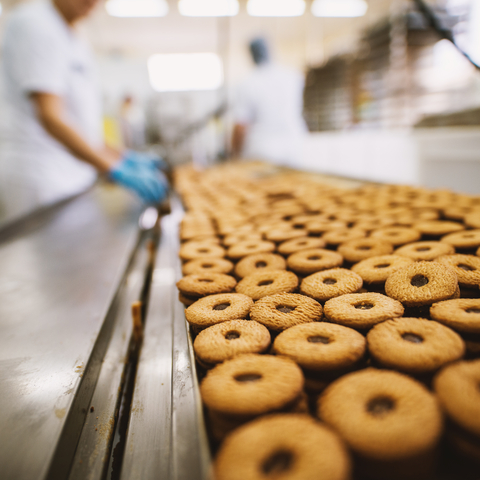Co Manufacturing vs. Self Manufacturing Food Products
This week’s blog is written by guest author Jordan Buckner.
We also have a few previous posts you might find useful as companions to this article for the various stages of thinking about, finding, and securing a co-packer: How and When to Find a Co-Packer, Talk the Talk with Food Co-Packers, and 7 Tips to Successfully Transition to a Larger Food Production Space.
To Self-Manufacture or Co-Manufacture?
Food entrepreneurs must decide between manufacturing products themselves or outsourcing to a contract manufacturer (co-manufacturer). As a food entrepreneur, I’ve experienced both production methods myself and have heard countless stories from other founders about their successes and failures with each. Let’s discuss each method so you can choose which path is right for you.

Here's what a co-manufacturing facility might look like with various types of equipment set up in an assembly line.
What is a Co-Manufacturer?
Co-manufactures are third-party production companies that allow you to produce your products without the upfront capital costs of building and managing your own facility. They have the expertise and experience to make your product efficiently. A good co-manufacturer will enable you to quickly increase your production volume to meet fast growing demand from new customers.
Working with a Co-Manufacturer
The business models of food startups and co-manufacturers have a central point of tension. As a food startup, you’re likely creating a new product with new ingredients or a new form designed to disrupt the market. This often means that products require complex or custom manufacturing processes. But co-manufacturers have specific pieces of equipment and are in the business of producing simple products with existing equipment at large volume. What may be surprising, is that each manufacturing line is actually a combination of a half dozen specific pieces of equipment that each do a specific task. The only flexibility comes from swapping out equipment, but many machines don’t work well together. If you need a specific machine, it can cost between $200,000 and $2,000,000. So if the co-manufacturer doesn’t have equipment to make your product, they likely aren’t going to make an investment just for you.
How do you make the relationship work?
If you’re a startup and want to work with a co-manufacturer, start by understanding what standard equipment is available to make similar products and design your product to fit into this process. For energy bar companies, for example, there are three methods for producing products – Slab Lines, Extruders, and Rotary Molding. If your product doesn’t fit within one of these three processes, then you’ll have a hard time finding a co-manufacturer, or you’ll have to buy any special equipment yourself.
For TeaSquares, I talked with a large manufacturer of energy bars that assured us they could make our product on their line, no problem. I set up a $7,500 test run to actually try it out. When the test day came, we spent 6 hours and 1000 lbs of ingredients trying to get the product to run, only for it not to work. The ingredients in my recipe were too loose to run on their slab method equipment and wouldn’t form into bars. This is when I realized that my recipe would only run on a rotary molder machine, and I would have to find someone else or buy the equipment myself.
Once you align your product to their equipment, communication is the second most important step. As with any good relationship, your success working with a co-manufacturer relies on setting mutual expectations and having an open line of communication. At one point last year, our sales were going great, and we requested another production run from our co-manufacturer two months in advance of when we needed inventory. They told me that it would be four months before we could get on the production schedule. They had a large client who just placed a multi-million dollar order, and we got bumped. Better communication on both sides would have alleviated the problem, as we could’ve done a production run prior to the new order starting. When interviewing co-manufacturers, make sure to find one that has an open and honest line of communication that can deliver on your expectations.
While most manufacturers won’t sign a contract starting out, it is valuable to have your terms in writing. Take a look at my manufacturing agreement sheet to see what things to discuss and feel free to use it as part of your conversations. This is not a comprehensive list of terms, so please review any agreements with an attorney.
The Co-Manufacturer Round Up
Working with a co-manufacturer can relieve a lot of headaches and time by making large volumes of your product so you can focus on growing the business. They are a great option for many companies and most large companies that you’re familiar with use them. I just recommend going in with realistic expectations so you don’t get blindsided:
The Good
- Quickly produce large volumes of product without large upfront equipment, facility, and employee costs.
- Outsourcing your manufacturing allows you to focus on sales and marketing to grow your business.
- Meet professional food safety standards often required by larger retailers.
The Bad
- May require high minimum order volumes resulting in higher than expected costs and extra inventory.
- Small brands often find it tough to work with co-manufacturers as their business models don’t align.
- Product quality won’t be as good.

Here's what a self manufacturing facility might look like - simpler equipment and more manual labor.
Self Manufacturing
Now that we’ve learned about co-manufacturing, let’s talk about the pros and cons of self manufacturing. Like most products, you probably started off making yours in your home kitchen. As you grow, you may still want to maintain control over the production to make sure the product is exactly how you want it. There are three main ways to self manufacture, so let's take a look at each.
1. Producing at Home Under Cottage Laws
Cottage Laws were set up to allow individuals to start a food business at home, as long as you’re using common ingredients and are typically selling under $1000 per month. States with Cottage Laws often don’t require you to have a business license or undergo a health inspection. Every state has different rules, so you can visit forrager to see what rules apply to your state.
2. Producing at a Shared Commercial Kitchen
Shared Commercial Kitchens are a great step when you’re looking to professionalize your business. These spaces are exactly as they sound, a shared commercially licensed facility with rental kitchens. Some allow you to pay by the hour, day, or month. You’re required to have a business license and have an inspection by your local health department. Some states may require you to have additional licensing if you’re selling your products wholesale (to a store to be resold). Shared spaces will provide basic equipment like ovens, tables, mixers, and sinks, but may not have specialized equipment. This is a great opportunity when you’re testing out the viability of your business.
3. Producing at Your Own Commercial Kitchen
Commercial Kitchens, when you fully lease or own your production facility, are the next step. This gives you the ultimate control, but also comes with increased risks. With this production method you’ll have complete control over your facility, equipment, and hours. You’ll also have to pay for the entire buildout to commercial grade and purchase all the equipment. This can be an expensive undertaking.
At this stage, you’ll also likely have employees. Hiring the right people from the start is incredibly important, as you need to trust them to make your product correctly, follow safety procedures, and show up every day. Once you have employees, you’ll have to buy Worker’s Compensation insurance and pay payroll taxes.
The Self-Manufacturing Round Up
Self-manufacturing provides you with the most control over the entire process, but also comes with increased costs and liability. For TeaSquares, I had a 4 person manufacturing team making products 5 days a week. Each week I spent about half my week managing manufacturing. That took a lot of time and mental energy. As a comparison, when I worked with a co-manufacturer, I would only need to spend a few days a month thinking about production, and the rest of that time I could focus on sales and marketing to grow the business.

Here's what a self-manufacturing storage room might look like with boxes of product and materials.
The Good
- I could produce inventory on demand so I didn’t have to have a bunch of product sitting around for weeks or months.
- I could use credit cards + vendor payment terms to finance most of our ingredient purchases.
- Product quality was at its all time high.
The Bad
- When Costco called, I had to turn down the opportunity. I would have to increase our production capacity (people and equipment) 10 times, and there was no guarantee they would order a second time.
- Every month I had to deal with a major employee issue.
- Our production line was inefficient as better equipment was outside our budget.
Start with the End in Mind
In deciding your path, start by understanding where you want to end up and build your business accordingly. Is your goal is to create a product to be sold across the country in your second year? Choosing a good manufacturer will help you quickly scale your production. If your goal is to grow a bit slower and create a unique product at the highest quality, you may want to self-manufacture.
For many businesses it's an evolution: they will start off self-manufacturing, then work with a co-manufacturer, and with success will bring their manufacturing back in house.
Good Luck!






